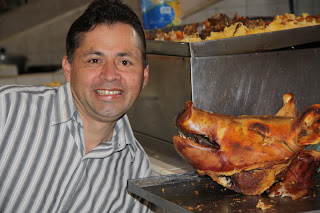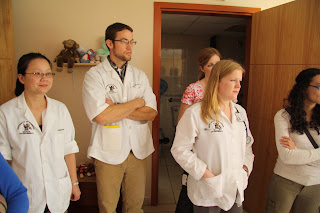 |
| Quito spreads out below the daycare on the hill |
We headed south instead of north out of Quito this morning, the sky a clear pale blue that gave us our first viewing of Cotopaxi, the volcano that normally stays hidden in the clouds. They say if you see Cotopaxi, then you will return to Ecuador. Once we left the busy rush hour traffic of the city, we turned up the eastern hills in our short bus, loaded with our three duffles and 4 boxes of supplies. We have been saving the majority of our children's chewable vitamins for our two days working in this day care center for children up to 5 years of age. We also brought hand knitted caps from a church in Virginia, a box of gliders and toys for all of the kids, several hundred tooth brushes in all sizes, 4 cases of toothpaste, and an assortment of lotions and shampoos that were donated. We don't travel light, but we do travel well prepared.

We drove up the narrow streets until the short bus could go no farther. So for the second time this trip, the van backed down the hill and we scrambled out to lighten the load. The daycare center was located near the top of a long street that went straight up the hill at a 45 degree angle. No, I'm not exaggerating. It really is 45 degrees, and how anything that is not four-wheel drive makes it up is beyond me. We huffed and puffed our way to the top and joined the small group of women and children sitting on the outside steps, waiting to be seen in our clinic. The van was able to make it up the hill without us, delivering our supplies. We set up our clinic and were ready to roll in under 15 minutes.

While we unpacked, Martin (our mission coordinator) and Jolene, the daycare director, started checking in patients, weighing and measuring all of the children, and Christy took blood pressures of all the adults. The daycare center is a large, tiered cement building perched on the steep hillside with a panoramic view of Quito and the mountains to the west. There is a large, cement playground on the first tier, with little painting stations topped by colorful striped beach umbrellas. Little potties is primary colors line one wall, and a classroom sits to the side.


Steep steps lead to a second tier, with a small kitchen and dining room, and up just a few more steps, the nap room, with bunk beds on one side and 4 cots on the other. These four cots became our exam tables. The pharmacy set up in the office. Each child from the daycare has a little file folder, which includes a growth chart. There is a big effort in Ecuador now to decrease the high prevalence of "stunting", undergrowth of children due to malnutrition. Ecuador has one of the higher rates of micronutrient malnutrition and undersize children in the world--as bad as some of the poorest African countries. We were impressed to see a list of the children who are undersized listed out neatly in the office, along with a list of children who are on vitamins.

The indigenous people here are often very tiny, but this is apparently due to a lack of nutrition, not solely genetics--the higher the altitude where people live, the worse the stunting, due to a lack of food variety. The first two years are the most critical--if children are stunted before age 2, they never catch up. We've learned all kinds of interesting things while working here. It didn't take long before our tiny space was crammed full of children, and their parents, siblings, and grandparents. We saw 80 people today, and only 30 of them were the daycare children--the majority were their family members. We have 50 more daycare children to see by noon tomorrow! The children of Ecuador are a pure delight--they are very open, friendly, loving and playful.

We had a great (if exhausting) day. Our mission ends tomorrow. We will spend the first half of the day seeing the remaining 50 daycare children, and then we have a going away party with the children at Camp Hope in the afternoon. Today was the last day with our whole team, however, as we had to say good-bye to Dr. Carrie Wilcox tonight--she flys back to the States tomorrow so she can take call Saturday night.
Life just keeps on moving, even when we are ready to stand still. Hasta manana.
learn more about Camp Hope
 |
| Dr. Mimi Choate with twins and their mom |
 You haven't lived
You haven't lived the deaf sing.
the deaf sing. We didn't save any lives, but we hugged a lot of people; the supplies we brought and didn't use are going to Dr. Marcus Nelson, who teaches and works in a family medicine residency here in Quito and in the jungle. He and I are already scheming about exchanging residents for rotations. I'm not sure why I was called to do this trip--I thought perhaps I would experience some epiphany; if I had one, I missed it. I did meet wonderful people who will be lifelong friends; I did learn to speak some Spanish; I had a great time.
We didn't save any lives, but we hugged a lot of people; the supplies we brought and didn't use are going to Dr. Marcus Nelson, who teaches and works in a family medicine residency here in Quito and in the jungle. He and I are already scheming about exchanging residents for rotations. I'm not sure why I was called to do this trip--I thought perhaps I would experience some epiphany; if I had one, I missed it. I did meet wonderful people who will be lifelong friends; I did learn to speak some Spanish; I had a great time.



























